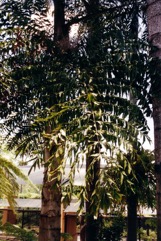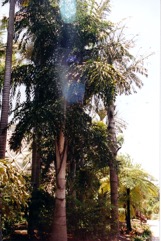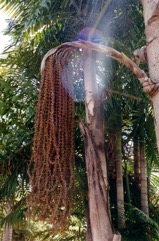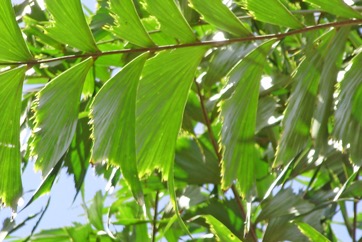Wine Palm, Fishtail Palm, Toddy Palm

A tropical plant. It grows in tropical and warm temperate regions. It likes a deep, rich soil. It grows in open, cleared areas of rainforest. It suits humid locations. The soil needs to be well drained. It Sri Lanka it grows up to 1,000 m above sea level. In XTBG Yunnan. It suits hardiness zones 10-12.
Also known as:
Anapana, Ardhashishi, Bagani, Baganimara, Bankhajur, Baraflawar, Berli, Berlimad, Bherawa, Bon supari, Cariota, Chaal gua, Cha guwa, Chao tamol, Chewa gach, Chhau, Dirgha, Dokechu, Dok kechu, Dong zong, Gol sago, Guobang, Ha da a bo, Jaggery palm, Jilugujattu, Kitul, Kittul, Koondalpanai, Koonthalpanai, Kundapana, Kwai-cha, Mada, Mari, Maype, Minbaw, Moahi, Nyod tao, Palma ribjega repa, Panamchapu, Panasoppu, Ramgua, Rangbhang, Rungbong, Sagu, Salopa, Shankarjata, Shivajata, Somong kung, Sowat goch, Surmadi, Taminbaw, Thippili panai, Tippili, Tippilipana, Tum, Tunsae, Tuum, Vazapana, Yiaobu
Edible Portion
- Sap, Starch, Cabbage, Sago, Palm heart, Fruit, Seeds - masticatory, Flower sap
Where does Wine Palm grow?
Found in: Africa, Asia, Australia, Bangladesh, Cambodia, China, Dominican Republic, East Africa, Fiji, Grenada, Guam, Guatemala, Hawaii, Himalayas, India, Indochina, Indonesia, Laos, Madagascar, Malaysia, Maldives, Marshall Islands, Micronesia, Mozambique, Myanmar, Nauru, Nepal, North America, Northeastern India, Pacific, Pakistan, Papua New Guinea, PNG, SE Asia, Senegal, Sikkim, Slovenia, Sri Lanka, Thailand, United States, Vietnam, West Africa, West Indies, Zimbabwe
Notes: There are 12 Caryota species. They are tropical.
Status: It is a cultivated food plant. Children chew the seeds.
Growing Wine Palm, Fishtail Palm, Toddy Palm
Cultivation: Plants are grown from seed. Seed germinate in 2-4 months. They can germinate in less than 1 month. It can tolerate sun while quite small.
Edible Uses: An edible starch can be extracted from the stem. The stem pith is boiled, mixed with rice and cooked. The palm heart is edible. The very young unfolded leaves are edible. They are boiled. The sap from the flower stalk is used for sugar or wine. For wine it is fermented and for sugar or jaggery it is boiled down. The seeds are used as a masticatory. They are chewed with betel leaf. The shoots are used to increase the taste of meat. CAUTION: The fruit contain stinging crystals.
Production: It is fast growing. From the cut flower clusters 20 litres of sap per day can be collected. A mature tree yields 30-40 kg of starch from the trunk. In Sikkim fruit are available in January.
Nutrition Info
per 100g edible portion| Edible Part | Energy (kcal) | Protein (g) | Iron (mg) | Vitamin A (ug) | Vitamin c (mg) | Zinc (mg) | % Water |
|---|---|---|---|---|---|---|---|
| Sap | - | - | - | - | - | - | |
| Stem starch | 339 | 2.4 | 20 | - | - | - | 13.1 |
| Palm heart | - | - | - | - | - | - | |
| Seeds | - | - | - | - | - | - |
Wine Palm, Fishtail Palm, Toddy Palm Photos




References
Ambasta S.P. (Ed.), 2000, The Useful Plants of India. CSIR India. p 108
Arinathan, V., et al, 2007, Wild edibles used by Palliyars of the western Ghats, Tamil Nadu. Indian Journal of Traditional Knowledge. 6(1) pp 163-168
Arora, R. K., 2014, Diversity in Underutilized Plant Species - An Asia-Pacific Perspective. Bioversity International. p 101
Aryal, K., Moe, A.T., Hein, P.P., Bay, Y.H.S., Htay, T., Aung, H.W., Shakya, B., Xuefei, Y., Shaoliang, Y. , 2020, Wild and non- cultivated edible plants and their contribution to local livelihoods in Putao, Myanmar. ICIMOD.
Ashton, M. S., et al 1997, A Field Guide to the Common Trees and Shrubs of Sri Lanka. WHT Publications Ltd. p 79
Azam, F. M. S., et al, 2014, Are Famine Food Plants Also Ethnomedicinal Plants? An Ethnomedicinal Appraisal of Famine Food Plants of Two Districts of Bangladesh. Evidence-Based Complementary and Alternative Medicine Volume 2014, Article ID 741712, 28 pages
Balick, M.J. and Beck, H.T., (Ed.), 1990, Useful palms of the World. A Synoptic Bibliography. Colombia p 105, 121, 160, 619,
Bandyopadhyay, S. et al, 2009, Wild edible plants of Koch Bihar district, West Bengal. Natural Products Radiance 8(1) 64-72
Bandyopadhyay, S., et al, 2012, A Census of Wild Edible Plants from Howrah District, West Bengal, India. Proceedings of UGC sponsored National Seminar 2012
Bircher, A. G. & Bircher, W. H., 2000, Encyclopedia of Fruit Trees and Edible Flowering Plants in Egypt and the Subtropics. AUC Press. p 88
Blomberry, A. & Rodd, T., 1982, Palms. An informative practical guide. Angus & Robertson. p 74
Bodkin, F., 1991, Encyclopedia Botanica. Cornstalk publishing, p 219
Bole, P.V., & Yaghani, Y., 1985, Field Guide to the Common Trees of India. OUP p 43
Brickell, C. (Ed.), 1999, The Royal Horticultural Society A-Z Encyclopedia of Garden Plants. Convent Garden Books. p 233
Brouk, B., 1975, Plants Consumed by Man. Academic Press, London. p 250, 365
Burkill, H. M., 1985, The useful plants of west tropical Africa, Vol. 4. Kew.
Burkill, I.H., 1966, A Dictionary of the Economic Products of the Malay Peninsula. Ministry of Agriculture and Cooperatives, Kuala Lumpur, Malaysia. Vol 1 (A-H) p 475
Chowdery, T., et al, 2014, Wild edible plants of Uttar Dinajpur District, West Bengal. Life Science Leaflets. 47:pp 20-36 http://lifesciencesleaflets.ning.com
Cundall, P., (ed.), 2004, Gardening Australia: flora: the gardener's bible. ABC Books. p 336
Dangol, D. R. et al, 2017, Wild Edible Plants in Nepal. Proceedings of 2nd National Workshop on CUAOGR, 2017.
Das, T. & Das, A. K., 2005, Inventorying plant biodiversity in homegardens: A case study in Barak Valley, Assam, North East India. CURRENT SCIENCE, VOL. 89, NO. 1, 10 JULY 2005
Davis, S.D., Heywood, V.H., & Hamilton, A.C. (eds), 1994, Centres of plant Diversity. WWF. Vol 1 or 2. p 109
Dharani, N., 2002, Field Guide to common Trees & Shrubs of East Africa. Struik. p 286
Etherington, K., & Imwold, D., (Eds), 2001, Botanica's Trees & Shrubs. The illustrated A-Z of over 8500 trees and shrubs. Random House, Australia. p 186
Ethnobotany of Karbis. Chapter 4 in p 107
Facciola, S., 1998, Cornucopia 2: a Source Book of Edible Plants. Kampong Publications, p 27
Gangte, H. E., et al, 2013, Wild Edible Plants used by the Zou Tribe in Manipur, India. International Journal of Scientific and Research Publications, Volume 3, Issue 5
Gibbons, M., 1993, Palms. Compact study Guide and Identifier. Sandstone. p 27
Ghimeray, A. K., Lamsal, K., et al, 2010, Wild edible angiospermic plants of the Illam Hills (Eastern Nepal) and their mode of use by local community. Korean J. Pl. Taxon. 40(1)
Ghosh, C. & Das A. P., 2011, Some useful and poisonous tea garden weeds from the Darjiling District of West Bengal, India. Pleione 5(1): 91 - 114
Guite, C., 2016, A study of wild edible plants associated with the Paite tribe of Manipur, India, International Journal of Current Research. Vol. 8, Issue, 11, pp. 40927-40932
Haynes, J., & McLaughlin, J., 2000, Edible palms and Their Uses. University of Florida Fact sheet MCDE-00-50-1 p 4
Hedrick, U.P., 1919, (Ed.), Sturtevant's edible plants of the world. p 173
Hibbert, M., 2002, The Aussie Plant Finder 2002, Florilegium. p 61
Hu, Shiu-ying, 2005, Food Plants of China. The Chinese University Press. p 302
Jeeva, S., 2009, Horticultural potential of wild edible fruits used by the Khasi tribes of Meghalaya. Journal or Horticulture and Forestry Vol. 1(9) pp. 182-192
Johnson, D.V., 1998, Tropical palms. Non-wood Forest products 10. FAO Rome. p 42, 121,
Jones, D.L., 1994, Palms throughout the World. Smithtonian Institution, Washington. p 51, 57, 165
Jones, D.L., 2000, Palms of Australia 3rd edition. Reed/New Holland. p 133
Kar, A., & Borthakur, S. K., 2008, Wild edible fruits of Karbi's of Karbi Anglong district of Assam, India, Pleione 2(2): 175-181
Kar, A., et al, 2013, Wild Edible Plant Resources used by the Mizos of Mizoram, India. Kathmandu University Journal of Science, Engineering and Technology. Vol. 9, No. 1, July, 2013, 106-126
Krishen P., 2006, Trees of Delhi, A Field Guide. DK Books. p 308
Lalfakzuala, R., 2007, Ethnobotanical usages of plants in western Mizoram. Indian Journal of Traditional Knowledge. Vol 6(3) pp 480-493
Lord, E.E., & Willis, J.H., 1999, Shrubs and Trees for Australian gardens. Lothian. p 94
Luczaj, L., et al, 2021, Wild food plants and fungi sold in the markets of Luang Prabang, Lao PDR. Journal of Ethnobiology and Ethnomedicine (2021) 17:6
Luo, B., et al, 2019, Wild edible plants collected by Hani from terraced rice paddy agroecosystem in Honghe Prefecture, Yunnan, China. Journal of Ethnobiology and Ethnomedicine 15:56
Mahadkar, S., Valvi, S. & Rathod, V., 2012, Nutritional assessment of some selected wild edible plants as a good source of mineral. Asian Journal of Plant Science and Research 2(4):468-472
Martin, M.A., 1971, Introduction L'Ethnobotanique du Cambodge. Centre National de la Recherche Scientifique. Paris.
Mozhui, R., et al, 2011, Wild edible fruits used by the tribals of Dimapur district of Nagaland, India. Pleione 5(1): 56 - 64.
Narayanan Ratheesh, M. K. et al, 2011, Wild edible plants used by the Kattunaikka, Paniya and Kuruma tribes of Wayanad District, Kerala, India. Journal of Medicinal Plants Research Vol. 5(15), pp. 3520-3529
Ogle, B. M., et al, 2003, Food, Feed or Medicine: The Multiple Functions of Edible Wild Plants in Vietnam. Economic Botany 57(1): 103-117
Partha, P., 2014, Ethnobotany of the Laleng (Patra) Community in Bangladesh. Journal of Pharmacognosy and Phytochemistry. 2(6):173-184
Patiri, B. & Borah, A., 2007, Wild Edible Plants of Assam. Geethaki Publishers. p 151
Phon, P., 2000, Plants used in Cambodia. © Pauline Dy Phon, Phnom Penh, Cambodia. p 136
Prashanth Kumar, G.M. and Shiddamallayya, N., 2015, Ethnobotanical Study of Less Known Wild Edible Plants of Hakki Pikki Tribes of Angadihalli, Hassan District, Karnataka. Journal or Medicinal Plants Studies 3(5):80-85
PROSEA (Plant Resources of South East Asia) handbook, Volume 9, 1996, Non seed carbohydrates
Purseglove, J.W., 1972, Tropical Crops. Monocotyledons. Longmans p 423
Rajapaksha, U., 1998, Traditional Food Plants in Sri Lanka. HARTI, Sri Lanka. p 360
Ramachandran,V. S., & Udhayavani, C., 2013, Knowledge and uses of wild edible plants by Paniyas and Kurumbas of Western Nilgiris, Tamil Nadu. Indian Journal of Natural Products and Resources. 4(4) December 2013, pp 412-418
Rao, M. L. S., et al, 2014, Indigenous Plant Foods which are commonly consumed by the tribal communities in Dumbriguda Area of Visakhapatnam District, Andhra Pradesh, India. Biolife. Vol 2, Issue 3
Rashid, H. E., 1977, Geography of Bangladesh. Westview. p 297
Recher, P, 2001, Fruit Spirit Botanical Gardens Plant Index. www.nrg.com.au/~recher/ seedlist.html p 7
Riffle, R.L. & Craft, P., 2003, An Encyclopedia of Cultivated Palms. Timber Press. p 292
Sahni, K.C., 2000, The Book of Indian Trees. Bombay Natural History Society. Oxford. p 183
Sarma, H., et al, 2010, Updated Estimates of Wild Edible and Threatened Plants of Assam: A Meta-analysis. International Journal of Botany 6(4): 414-423
Savita, et al, 2006, Studies on wild edible plants of ethnic people in east Sikkim. Asian J. of Bio Sci. (2006) Vol. 1 No. 2 : 117-125
Sawian, J. T., et al, 2007, Wild edible plants of Meghalaya, North-east India. Natural Product Radiance Vol. 6(5): p 414
Singh, B., et al, 2012, Wild edible plants used by Garo tribes of Nokrek Biosphere Reserve in Meghalaya, India. Indian Journal of Traditional Knowledge. 11(1) pp 166-171
Smith, A.C., 1979, Flora Vitiensis Nova: A New flora of Fiji, Hawai Botanical Gardens, USA Vol 1 p 408
Sp. pl. 2:1189. 1753
Staples, G.W. and Herbst, D.R., 2005, A tropical Garden Flora. Bishop Museum Press, Honolulu, Hawaii. p 619
Sujanapal, P., & Sankaran, K. V., 2016, Common Plants of Maldives. FAO & Kerala FRI, p 70
Suksri, S., et al, 2005, Ethnobotany in Bung Khong Long Non-Hunting Area, Northeast Thailand. Kasetsart J., (Nat. Sci) 39: 519-533
Sundriyal, M., et al, 1998, Wild edibles and other useful plants from the Sikkim Himalaya, India. Oecologia Montana 7:43-54
Sundriyal, M., et al, 2004, Dietary Use of Wild Plant Resources in the Sikkim Himalaya, India. Economic Botany 58(4) pp 626-638
Swaminathan, M.S., and Kochnar, S.L., 2007, An Atlas of major Flowering Trees in India. Macmillan. p 272
Teron, R. & Borthakur, S. K., 2016, Edible Medicines: An Exploration of Medicinal Plants in Dietary Practices of Karbi Tribal Population of Assam, Northeast India. In Mondal, N. & Sen, J.(Ed.) Nutrition and Health among tribal populations of India. p 149
Uprety, Y., et al, 2016, Traditional use and management of NTFPs in Kangchenjunga Landscape: implications for conservation and livelihoods. Journal of Ethnobiology and Ethnomedicine (2016) 12:19
Vander Velde, N, 2003, The Vascular Plants of Majuro Atoll, Republic of the Marshall Islands. Atoll research Bulletin. No. 503. Smithsonian Institute. p 31
van Wyk, B., 2005, Food Plants of the World. An illustrated guide. Timber press. p 123
WATT,
Wild edible plants of Himachal Pradesh
Wong, M., 2006, Edible Plants for Hawai'i Landscapes. College of Tropical Agriculture and Human Resources. Univ. of Hawai'i
World Checklist of Useful Plant Species 2020. Royal Botanic Gardens, Kew
www.worldagroforestrycentre.org/treedb/
Xu, You-Kai, et al, 2004, Wild Vegetable Resources and Market Survey in Xishuangbanna, Southwest China. Economic Botany. 58(4): 647-667.